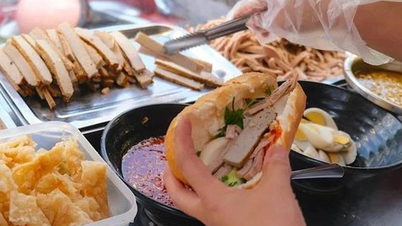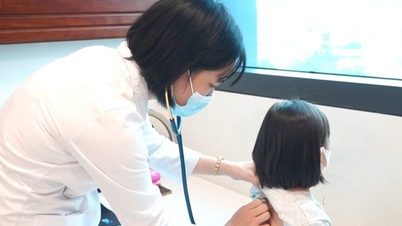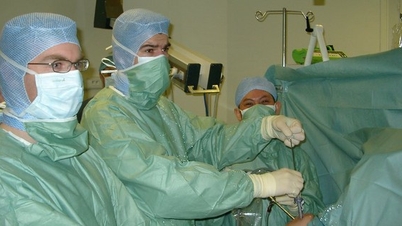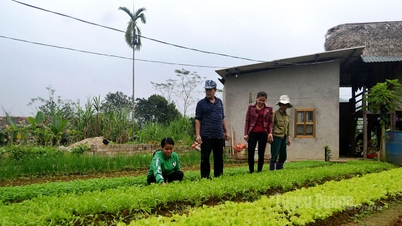 |
| Many types of bacteria are "hidden" in poor quality mixed bread. |
Pate sandwiches and mixed-filling sandwiches are convenient, quick, and familiar dishes. However, hidden behind the crispy crust and attractive fillings are potential health risks if the ingredients, preparation, and storage are not safe.
Several bread poisoning cases have shown that ingredients such as pate, char siu... (which are easily contaminated with Salmonella, Listeria or dangerous Botulinum toxin), along with pre-processed fillings and unhygienic raw vegetables, are the "seeds" causing the disease.
Lack of control over ingredients, storage temperature and cleaning of processing equipment makes food easily cross-contaminated, posing an especially serious threat to the health of children, the elderly and pregnant women.
1. Risk of poisoning from some bacteria
Listeria: Frozen pâté or meat spreads may be contaminated with Listeria if they are produced in a facility where Listeria bacteria are present. Refrigeration does not kill Listeria.
Salmonella: Commonly found in fresh produce, poultry. If pate is not cooked thoroughly or stored properly, this bacteria can thrive. Salmonella thrives in warm, moist environments.
E.Coli: Another type of bacteria that can also appear in unsanitary food, mainly transmitted from unwashed raw vegetables or through cross-contamination from utensils and hands. This bacteria is also found in unsanitary processed meats and pate, causing diarrhea and severe abdominal pain.
Botulinum toxin: This is an extremely dangerous toxin that can appear in canned or unhygienic processed products (has occurred in commercial pate poisoning cases).
2. Delicious foods can be hidden enemies due to bacterial contamination
Pate: The risk of poisoning from pate mainly comes from the quality and preservation of pate - this is the ingredient most susceptible to bacterial contamination due to its rich nutrition and easy spoilage (usually from pork liver, chicken liver). Pate is an ideal environment for Salmonella and Listeria bacteria to grow, especially when stored at room temperature or not cooked thoroughly. Botulinum toxin can appear if canned pate does not meet standards.
In addition to pate, the following ingredients are potential sources of food poisoning in bread when hygiene is not ensured:
Raw vegetables, cucumbers, herbs: The main risk is due to E.Coli and Salmonella bacteria or parasites. Raw vegetables are easily contaminated by soil, irrigation water, unclean washing water, or by unsanitary preparation (hands, tools). Some studies on bread poisoning often found bacteria on raw vegetables or pickles.
Cold cuts, ham, sausages: The main risk is Listeria and Salmonella or Staphylococcus aureus bacteria. These are processed, cooked foods that are often refrigerated and sold. Listeria can grow well in the refrigerator, making these products dangerous if not strictly controlled in temperature.
Staphylococcus aureus can grow rapidly if cold cuts/ham are handled with dirty hands or left at room temperature for too long, producing toxins.
Other ingredients such as sauces, butter, eggs: If sauces are made from fresh eggs or are homemade and not refrigerated (below 4°C), they can be a source of Salmonella or Staphylococcus aureus contamination.
Pickled foods such as papaya and carrots: If the pickling process is not hygienic, it can be contaminated by other intestinal bacteria.
Thus, the risk lies not only in pate but also in any ingredient that is rich in nutrients, protein (such as meat, ham) or is not washed/processed thoroughly (such as raw vegetables) and is displayed for a long time in conditions of not strictly controlled temperature.
3. Who should avoid or take special precautions when eating street bread?
The following groups of people have weaker immune systems or are at higher risk of complications from food poisoning:
Children: The immune system is immature and easily affected by bacteria such as Salmonella.
Elderly: Weakened immune system, poorer recovery ability.
Pregnant women: Food poisoning can affect the health of both mother and fetus.
People with chronic underlying diseases: Such as diabetes, digestive diseases, or people using immunosuppressants.
4. Prevention
To prevent bread poisoning, choose a reputable establishment with good hygiene conditions and a clear origin of ingredients. Always ensure that pate, cold cuts, and ham are kept cold (below 4 degrees Celsius) and within the expiry date. If it is canned pate, absolutely do not use cans that are swollen, dented, rusted, or expired.
Require meat fillings to be heated if possible. Raw vegetables and pickles should be cleaned and thoroughly soaked. Avoid eating bread with fillings that have been left out for a long time or that show signs of change in color or flavor.
Vulnerable groups (children, pregnant women, the elderly) should prioritize homemade foods.
Source: https://baoquocte.vn/nguy-co-tiem-an-tu-vi-khuong-trong-banh-mi-thap-cam-kem-chat-luong-333819.html


![[Photo] General Secretary To Lam visits Long Thanh International Airport Project](https://vphoto.vietnam.vn/thumb/1200x675/vietnam/resource/IMAGE/2025/11/13/1763008564398_vna-potal-tong-bi-thu-to-lam-tham-du-an-cang-hang-khong-quoc-te-long-thanh-8404600-1261-jpg.webp)

































































































![Dong Nai OCOP transition: [Article 3] Linking tourism with OCOP product consumption](https://vphoto.vietnam.vn/thumb/402x226/vietnam/resource/IMAGE/2025/11/10/1762739199309_1324-2740-7_n-162543_981.jpeg)







Comment (0)